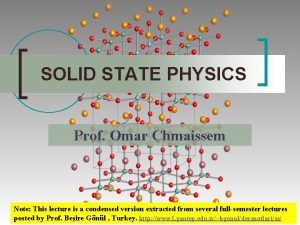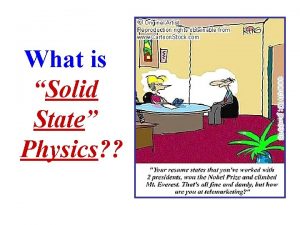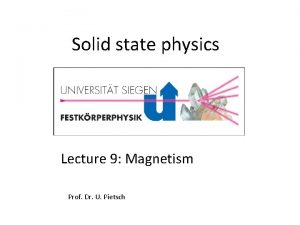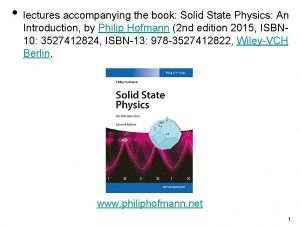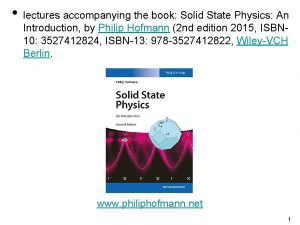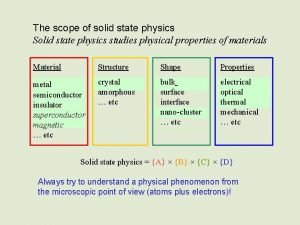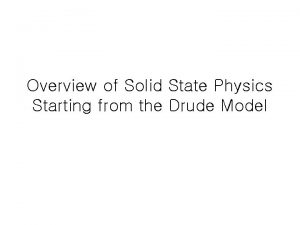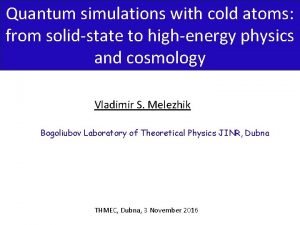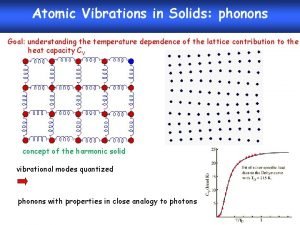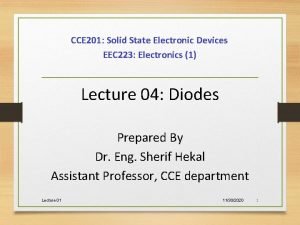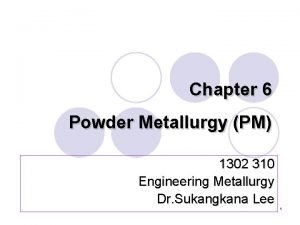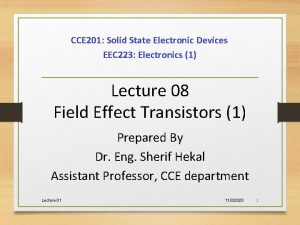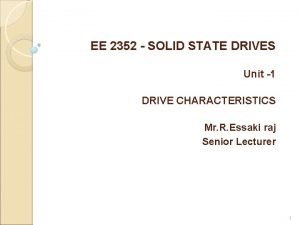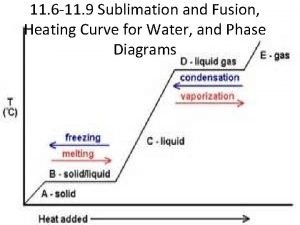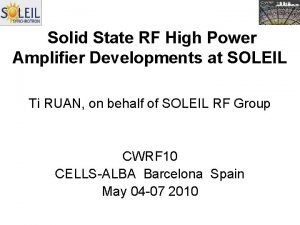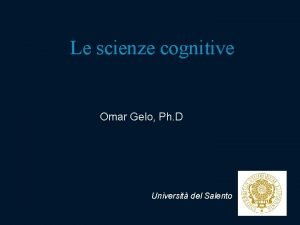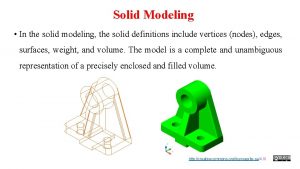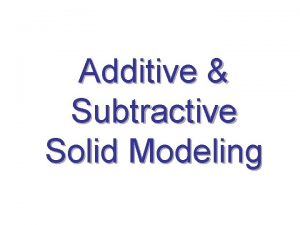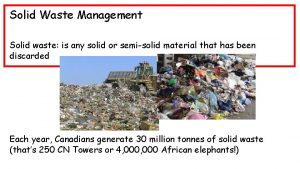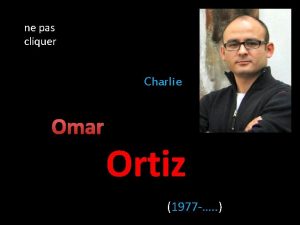SOLID STATE PHYSICS Prof Omar Chmaissem Note This





































































- Slides: 69

SOLID STATE PHYSICS Prof. Omar Chmaissem Note: This lecture is a condensed version extracted from several full-semester lectures posted by Prof. Beşire Gönül , Turkey. http: //www 1. gantep. edu. tr/~bgonul/dersnotlari/ss/

What is solid state physics? n Explains the properties of solid materials. n Explains the properties of a collection of atomic nuclei and electrons interacting with electrostatic forces. n Formulates fundamental laws that govern the behavior of solids.

Crystalline Solids n Crystalline materials are solids with an atomic structure based on a regular repeated pattern. n The majority of all solids are crystalline. n More progress has been made in understanding the behavior of crystalline solids than that of noncrystalline materials since the calculation are easier in crystalline materials. n Understanding the electrical properties of solids is right at the heart of modern society and technology.

Electrical resistivity of three solid Carbon states n How can this be? After all, they each contain a system of atoms and especially electrons of similar density. And the plot thickens: graphite is a metal, diamond is an insulator and buckminster-fullerene is a superconductor. They are all just carbon!

LECTURE’S OUTLINE n Part 1. Crystal Structures n Part 2. Interatomic Forces n Part 3. Crystal Dynamics

PART 1 CRYSTAL STRUCTURES Elementary Crystallography Solid materials (crystalline, polycrystalline, amorphous) Crystallography Crystal Lattice Crystal Structure Types of Lattices Unit Cell Typical Crystal Structures (3 D– 14 Bravais Lattices and the Seven Crystal System)


CLASSIFICATION OF SOLIDS SOLID MATERIALS CRYSTALLINE POLYCRYSTALLINE AMORPHOUS (Non-crystalline) Single Crystal Structure 8

SINGLE CRYSTALS n n Single crystals have a periodic atomic structure across its whole volume. At long range length scales, each atom is related to every other equivalent atom in the structure by translational or rotational symmetry Single Pyrite Crystal Amorphous Solid Single Crystals 9

POLYCRYSTALLINE SOLIDS n n n Polycrystalline materials are made up of an aggregate of many small single crystals (also called crystallites or grains). Polycrystalline materials have a high degree of order over many atomic or molecular dimensions. Grains (domains) are separated by grain boundaries. The atomic order can vary from one domain to the next. The grains are usually 100 nm - 100 microns in diameter. Polycrystals with grains less than 10 nm in diameter are nanocrystalline Polycrystalline Pyrite form (Grain) 10

AMORPHOUS SOLIDS n n n Amorphous (Non-crystalline) Solids are made up of randomly orientated atoms , ions, or molecules that do not form defined patterns or lattice structures. Amorphous materials have order only within a few atomic or molecular dimensions. Amorphous materials do not have any long-range order, but they have varying degrees of short-range order. Examples to amorphous materials include amorphous silicon, plastics, and glasses. Amorphous silicon can be used in solar cells and thin film transistors. 11

CRYSTALLOGRAPHY Crystallography is a branch of science that deals with the geometric description of crystals and their internal atomic arrangement. It’s important the symmetry of a crystal because it has a profound influence on its properties. Structures should be classified into different types according to the symmetries they possess. Energy bands can be calculated when the structure has been determined. 12

CRYSTAL LATTICE What is a crystal lattice? In crystallography, only the geometrical properties of the crystal are of interest, therefore one replaces each atom by a geometrical point located at the equilibrium position of that atom. Platinum surface (scanning tunneling microscope) Crystal lattice and structure of Platinum 13

Crystal Lattice y n An infinite array of points in space, B C α b n Each point has identical surroundings to all others. n Arrays are arranged in a periodic manner. O a D A E x 14

Crystal Structure n Crystal structures can be obtained by attaching atoms, groups of atoms or molecules which are called basis (motif) to the lattice sides of the lattice point. Crystal Structure = Crystal Lattice + Basis 15

A two-dimensional Bravais lattice with different choices for the basis

Five Bravais Lattices in 2 D 17

Unit Cell in 2 D n The smallest component of the crystal (group of atoms, ions or molecules), which when stacked together with pure translational repetition reproduces the whole crystal. b S a S S S S 18

Unit Cell in 3 D Crystal Structure 19

Three common Unit Cells in 3 D 20

Unit Cell n n n The unit cell and, consequently, the entire lattice, is uniquely determined by the six lattice constants: a, b, c, α, β and γ. Only 1/8 of each lattice point in a unit cell can actually be assigned to that cell. Each unit cell in the figure can be associated with 8 x 1/8 = 1 lattice point. 21

TYPICAL CRYSTAL STRUCTURES 3 D – 14 BRAVAIS LATTICES AND SEVEN CRYSTAL TYPES n n n n Cubic Crystal System (SC, BCC, FCC) Hexagonal Crystal System (S) Triclinic Crystal System (S) Monoclinic Crystal System (S, Base-C) Orthorhombic Crystal System (S, Base-C, BC, FC) Tetragonal Crystal System (S, BC) Trigonal (Rhombohedral) Crystal System (S) 22

Crystal Structure 23

Sodium Chloride Structure n n n Sodium chloride also crystallizes in a cubic lattice, but with a different unit cell. Sodium chloride structure consists of equal numbers of sodium and chlorine ions placed at alternate points of a simple cubic lattice. Each ion has six of the other kind of ions as its nearest neighbours. 24


PART 2 INTERATOMIC FORCES What kind of forces hold the atoms together in a solid? Energies of Interactions Between Atoms Ionic bonding Na. Cl Covalent bonding Comparison of ionic and covalent bonding Metallic bonding Van der waals bonding Hydrogen bonding

Energies of Interactions Between Atoms ¡ The energy of the crystal is lower than that of the free atoms by an amount equal to the energy required to pull the crystal apart into a set of free atoms. This is called the binding (cohesive) energy of the crystal. l l Na. Cl is more stable than a collection of free Na and Cl. Ge crystal is more stable than a collection of free Ge. Cl Na Na. Cl

Types of Bonding Mechanisms It is conventional to classify the bonds between atoms into different types as ¡ ¡ ¡ Ionic Covalent Metallic Van der Waals Hydrogen All bonding is a consequence of the electrostatic interaction between the nuclei and electrons.

IONIC BONDING Ionic bonding is the electrostatic force of attraction between positively and negatively charged ions (between non-metals and metals). All ionic compounds are crystalline solids at room temperature. Na. Cl is a typical example of ionic bonding.

ative Metallic elements have only up to the valence electrons in their outer shell. When losing their electrons they become positive ions. electrons to become negative ions or anions. Na Cl

¡ When the Na+ and Cl- ions approach each other closely enough so that the orbits of the electron in the ions begin to overlap with each other, then the electron begins to repel each other by virtue of the repulsive electrostatic coulomb force. Of course the closer together the ions are, the greater the repulsive force. ¡ Pauli exclusion principle has an important role in repulsive force. To prevent a violation of the exclusion principle, the potential energy of the system increases very rapidly.

COVALENT BONDING ¡ Covalent bonding takes place between atoms with small differences in electronegativity which are close to each other in the periodic table (between nonmetals and non-metals). ¡ The covalent bonding is formed when the atoms share the outer shell electrons (i. e. , s and p electrons) rather than by electron transfer. ¡ Noble gas electron configuration can be attained.

¡ Each electron in a shared pair is attracted to both nuclei involved in the bond. The approach, electron overlap, and attraction can be visualized as shown in the following figure representing the nuclei and electrons in a hydrogen molecule. e e

Comparison of Ionic and Covalent Bonding

METALLIC BONDING ¡ ¡ Metallic bonding is found in metal elements. This is the electrostatic force of attraction between positively charged ions and delocalized outer electrons. The metallic bond is weaker than the ionic and the covalent bonds. A metal may be described as a low-density cloud of free electrons. Therefore, metals have high electrical and thermal conductivity. + + + + +

¡ VAN DER WAALS These are weak bonds with. BONDING a typical strength 0. 2 e. V/atom. of ¡ Van Der Waals bonds occur between neutral atoms and molecules. ¡ Weak forces of attraction result from the natural fluctuations in the electron density of all molecules that cause small temporary dipoles to appear within the molecules. ¡ It is these temporary dipoles that attract one molecule to another. They are called van der Waals' forces.

¡ ¡ The shape of a molecule influences its ability to form temporary dipoles. Long thin molecules can pack closer to each other than molecules that are more spherical. The bigger the 'surface area' of a molecule, the greater the van der Waal's forces will be and the higher the melting and boiling points of the compound will be. Van der Waal's forces are of the order of 1% of the strength of a covalent bond. Homonuclear molecules, such as iodine, develop temporary dipoles due to natural fluctuations of electron density within the molecule Heteronuclear molecules, such as H-Cl have permanent dipoles that attract the opposite pole in other molecules.

¡ ¡ These forces are due to the electrostatic attraction between the nucleus of one atom and the electrons of the other. Van der waals interaction occurs generally between atoms which have noble gas configuration. van der waals bonding

HYDROGEN BONDING ¡ ¡ n A hydrogen atom, having one electron, can be covalently bonded to only one atom. However, the hydrogen atom can involve itself in an additional electrostatic bond with a second atom of highly electronegative character such as fluorine or oxygen. This second bond permits a hydrogen bond between two atoms or strucures. The strength of hydrogen bonding varies from 0. 1 to 0. 5 ev/atom. Hydrogen bonds connect water molecules in ordinary ice. Hydrogen bonding is also very important in proteins and nucleic acids and therefore in life processes.

Types of Bonding Ionic Bonding High Melting Point Hard and Brittle Van Der Waals Bonding Low Melting Points Na. Cl, Cs. Cl, Zn. S Variable Melting Point Covalent Bonding Hydrogen Bonding Very High Melting Point Low Melting Points Soft and Brittle Non-Conducting Non conducting solid Metallic Bonding Ne, Ar, Kr and Xe Variable Hardness Conducting Fe, Cu, Ag Very Hard Usually not Conducting Diamond, Graphite Usually Non-Conducting İce, organic solids

PART 3 CRYSTAL DYNAMICS Ø Ø SOUND WAVES LATTICE VIBRATIONS OF 1 D CRYSTALS chain of identical atoms Ø chain of two types of atoms Ø Ø Ø LATTICE VIBRATIONS OF 3 D CRYSTALS PHONONS HEAT CAPACITY FROM LATTICE VIBRATIONS ANHARMONIC EFFECTS THERMAL CONDUCTION BY PHONONS

Crystal Dynamics Atomic motions are governed by the forces exerted on atoms when they are displaced from their equilibrium positions. To calculate the forces it is necessary to determine the wavefunctions and energies of the electrons within the crystal. Fortunately many important properties of the atomic motions can be deduced without doing these calculations.

Hooke's Law One of the properties of elasticity is that it takes about twice as much force to stretch a spring twice as far. This linear dependence of displacement upon stretching is called Hooke's law. It takes twice as much force to stretch a spring twice as far. Spring constant k

SOUND WAVES waves are waves which propagate a • Mechanical It corresponds to the atomic vibrations with a longthrough λ. material medium (solid, liquid, or gas) at a wave speed which depends on the elastic and inertial properties of that • medium. Presence. There of atoms significance this wavelength are has twono basic types ofinwave motion for limit, since λ>>a, there will nowaves scattering due to the mechanical waves: solongitudinal and transverse presence of atoms. waves. Longitudinal Waves Transverse Waves

SOUND WAVES Sound waves propagate through solids. This tells us that wavelike lattice vibrations of wavelength long compared to the interatomic spacing are possible. The detailed atomic structure is unimportant for these waves and their propagation is governed by the macroscopic elastic properties of the crystal. We discuss sound waves since they must correspond to the low frequency, long wavelength limit of the more general lattice vibrations considered later in this chapter. At a given frequency and in a given direction in a crystal it is possible to transmit three sound waves, differing in their direction of polarization and in general also in their velocity.

Speed of Sound Wave The speed with which a longitudinal wave moves through a liquid of density ρ is C = Elastic bulk modulus ρ = Mass density • The velocity of sound is in general a function of the direction of propagation in crystalline materials. • Solids will sustain the propagation of transverse waves, which travel more slowly than longitudinal waves. • The larger the elastic modules and smaller the density, the more rapidly can sound waves travel.

Sound Wave Speed of sound for some typical solids Structure Type Nearest Neighbour Distance (A°) Density ρ (kg/m 3) Elastic bulk modules Y (1010 N/m 2) Calculate d Wave Speed (m/s) Observed speed of sound (m/s) Sodium B. C. C 3. 71 970 0. 52 2320 2250 Copper F. C. C 2. 55 8966 13. 4 3880 3830 Aluminum F. C. C 2. 86 2700 7. 35 5200 5110 Lead F. C. C 3. 49 11340 4. 34 1960 1320 Silicon Diamond 2. 35 2330 10. 1 6600 9150 Germanium Diamond 2. 44 5360 7. 9 3830 5400 Na. Cl Rocksalt 2. 82 2170 2. 5 3400 4730 Solid • VL values are comparable with direct observations of speed of sound. • Sound speeds are of the order of 5000 m/s in typical metallic, covalent and ionic solids.

Sound Wave Speed A lattice vibrational wave in a crystal is a repetitive and systematic sequence of atomic displacements of longitudinal, transverse, or some combination of the two • An equation of motion for any displacement can be • produced They can be by by characterized means of considering the restoring forces –A propagation velocity, v on displaced atoms. – Wavelength or wavevector • As a result we λcan generate a dispersion relationship between frequency wavelength or ω=2π between angular – A frequency or and angular frequency and wavevector.

Monoatomic Chain The simplest crystal is the one dimensional chain of identical atoms. Chain consists of a very large number of identical atoms with identical masses. Atoms are separated by a distance of “a”. Atoms move only in a direction parallel to the chain. Only nearest neighbours interact (short-range forces). a a Un-2 a Un-1 a Un+1 a Un+2

Chain of two types of atom Two different types of atoms of masses M and m are connected by identical springs of spring constant K; (n-2) (n-1) K (n) K M m (n+1) K M (n+2) K m M a) a b) Un-2 Un-1 Un Un+1 Un+2 • This is the simplest possible model of an ionic crystal. • Since a is the repeat distance, the nearest neighbors separations is a/2

Chain of two types of atom ω (angular frequency) versus k (wavevector) relation for diatomic chains w A –л/a • • 0 B C л/a 2 л/a k Normal modecontains frequencies of acells chain two types of atoms. If the crystal N unit weofwould expect to find At A, the two atoms are oscillating in antiphase with their centre of 2 N normal modes of vibrations and this is the total number of mass at rest; atoms and hence the total number of and equations motion for at B, the lighter mass m is oscillating M is atof rest; mass Misand m. at C, M oscillating and m is at rest.

Chain of two types of atom As there are two values of ω for each value of k, the dispersion relation is said to have two branches; w A –л/a 0 Optical Branch Upper branch is due to the +ve sign of the root. B C л/a 2 л/a k Acoustical Branch Lower branch is due to the -ve sign of the root. • The dispersion relation is periodic in k with a period 2 π /a = 2 π /(unit cell length). • This result remains valid for a chain containing an arbitrary number of atoms per unit cell.

Acoustic/Optical Branches The acoustic branch has this name because it gives rise to long wavelength vibrations - speed of sound. The optical branch is a higher energy vibration (the frequency is higher, and you need a certain amount of energy to excite this mode). The term “optical” comes from how these were discovered - notice that if atom 1 is +ve and atom 2 is -ve, that the charges are moving in opposite directions. You can excite these modes with electromagnetic radiation (ie. The oscillating electric fields generated by EM radiation)

Transverse optical mode for diatomic chain Amplitude of vibration is strongly exaggerated!

Transverse acoustical mode for diatomic chain

Phonons Consider the regular lattice of atoms in a uniform solid material. There should be energy associated with the vibrations of these atoms. But they are tied together with bonds, so they can't vibrate independently. The vibrations take the form of collective modes which propagate through the material. Such propagating lattice vibrations can be considered to be sound waves. And their propagation speed is the speed of sound in the material.

Phonons The vibrational energies of molecules are quantized and treated as quantum harmonic oscillators. Quantum harmonic oscillators have equally spaced energy levels with separation ΔE = h. So the oscillators can accept or lose energy only in discrete units of energy h. The evidence on the behaviour of vibrational energy in periodic solids is that the collective vibrational modes can accept energy only in discrete amounts, and these quanta of energy have been labelled "phonons".

PHONONS • Quanta of lattice vibrations • Energies of phonons are quantized PHOTONS • Quanta of electromagnetic radiation • Energies of photons are quantized as well ~a 0=10 -10 m ~10 -6 m

Thermal energy and lattice vibrations • Atoms vibrate about their equilibrium position. • They produce vibrational waves. • This motion increases as the temperature is raised. In solids, the energy associated with this vibration and perhaps also with the rotation of atoms and molecules is called thermal energy. Note: In a gas, the translational motion of atoms and molecules contribute to this energy.

Therefore, the concept of thermal energy is fundamental to the understanding many of the basic properties of solids. We would like to know: • What is the value of this thermal energy? • How much is available to scatter a conduction electron in a metal; since this scattering gives rise to electrical resistance. • The energy can be used to activate a crystallographic or a magnetic transition. • How the vibrational energy changes with temperature since this gives a measure of the heat energy which is necessary to raise the temperature of the material. • Recall that the specific heat or heat capacity is thermal energy which is required to raise the temperature of unit mass or 1 g mole by one Kelvin.

Heat capacity from Lattice vibrations Energy given to lattice vibrations is the dominant contribution to the heat capacity in most solids. In non-magnetic insulators, it is the only contribution. Other contributions: • In metals from the conduction electrons. • In magnetic materials from magneting ordering. Atomic vibrations lead to bands of normal mode frequencies from zero up to some maximum value. Calculation of the lattice energy and heat capacity of a solid therefore falls into two parts: i) the evaluation of the contribution of a single mode, and ii) the summation over the frequency distribution of the modes.

Plot of as a function of T Specific heat at constant volume depends on temperature as shown in figure below. At high temperatures the value of Cv is close to 3 R, where R is the universal gas constant. Since R is approximately 2 cal/K-mole, at high temperatures Cv is app. 6 cal/K-mole. This range usually includes RT. From the figure it is seen that Cv is equal to 3 R at high temperatures regardless of the substance. This fact is known as Dulong-Petit law. This law states that specific heat of a given number of atoms of any solid is independent of temperature and is the same for all materials!

Additional Reading

Density of States According to Quantum Mechanics if a particle is constrained; the energy of particle can only have special discrete energy values. it cannot increase infinitely from one value to another. it has to go up in steps.

These steps can be so small depending on the system that the energy can be considered as continuous. This is the case of classical mechanics. But on atomic scale the energy can only jump by a discrete amount from one value to another. Definite energy levels Steps get small Energy is continuous

In some cases, each particular energy level can be associated with more than one different state (or wavefunction ) This energy level is said to be degenerate. The density of states is the number of discrete states per unit energy interval, and so that the number of states between and will be.

Anharmonic Effects Any real crystal resists compression to a smaller volume than its equilibrium value more strongly than expansion due to a larger volume. This is due to the shape of the interatomic potential curve. This is a departure from Hooke’s law, since harmonic application does not produce this property. This is an anharmonic effect due to the higher order terms in potential which are ignored in harmonic approximation. Thermal expansion is an example to the anharmonic effect. In harmonic approximation phonons do not interact with each other, in the absence of boundaries, lattice defects and impurities (which also scatter the phonons), thermal conductivity is infinite. In anharmonic effect phonons collide with each other and these collisions limit thermal conductivity which is due to the flow of phonons.

Phonon-phonon collisions The coupling of normal modes by the unharmonic terms in the interatomic forces can be pictured as collisions between the phonons associated with the modes. A typical collision process of phonon 1 After collision another phonon is produced phonon 2 and conservation of energy conservation of momentum

Thermal conduction by phonons A flow of heat takes place from a hotter region to a cooler region when there is a temperature gradient in a solid. The most important contribution to thermal conduction comes from the flow of phonons in an electrically insulating solid. Transport property is an example of thermal conduction. Transport property is the process in which the flow of some quantity occurs. Thermal conductivity is a transport coefficient and it describes the flow. The thermal conductivity of a phonon gas in a solid will be calculated by means of the elementary kinetic theory of the transport coefficients of gases.
 Omar chmaissem
Omar chmaissem Mannaar helsinki
Mannaar helsinki Define solid state physics
Define solid state physics Magnetism in solid state physics
Magnetism in solid state physics Philip hofmann solid state physics
Philip hofmann solid state physics Philip hofmann solid state physics
Philip hofmann solid state physics Solid
Solid Solid state physics
Solid state physics Solid state physics
Solid state physics Solid state physics
Solid state physics Drude model solid state physics
Drude model solid state physics Solid state physics
Solid state physics Solid
Solid Simulations for solid state physics
Simulations for solid state physics Understanding solid state physics
Understanding solid state physics Philip hofmann solid state physics
Philip hofmann solid state physics Difference between note making and note taking
Difference between note making and note taking Signal words
Signal words Difference between note making and note taking
Difference between note making and note taking Financial documents in order
Financial documents in order Debit note example
Debit note example What is credit note and debit note
What is credit note and debit note Note making advantages
Note making advantages Simple discount example
Simple discount example Crystalline vs amorphous
Crystalline vs amorphous Solid solution example
Solid solution example Covalent molecular and covalent network
Covalent molecular and covalent network Lattice basis
Lattice basis Crystalline solids
Crystalline solids Crystalline solid and amorphous solid
Crystalline solid and amorphous solid Anisotropic meaning in chemistry
Anisotropic meaning in chemistry When a solid completely penetrates another solid
When a solid completely penetrates another solid Interpenetration of solids
Interpenetration of solids Separation by evaporation
Separation by evaporation From solid state to biophysics
From solid state to biophysics Difference between submerged and solid state fermentation
Difference between submerged and solid state fermentation Solid state diode definition
Solid state diode definition Solid state electronic devices 7th solution chapter 4
Solid state electronic devices 7th solution chapter 4 Has actuado alguna vez como un héroe
Has actuado alguna vez como un héroe Metal deficiency defect
Metal deficiency defect Powder metallurgy
Powder metallurgy Solid state electronic devices ppt
Solid state electronic devices ppt Types of electrodes used in surgical diathermy
Types of electrodes used in surgical diathermy Solid state diode definition
Solid state diode definition Ozone solid state
Ozone solid state 4 quadrant operation of induction motor
4 quadrant operation of induction motor Solid state power amplifier definition
Solid state power amplifier definition Projektlabor tu berlin
Projektlabor tu berlin Sublimation fusion
Sublimation fusion Solid state high power amplifier
Solid state high power amplifier Sidecar asic
Sidecar asic Solid-state lighting (ssl)
Solid-state lighting (ssl) Solid state welding wikipedia
Solid state welding wikipedia Why does it happen
Why does it happen University physics with modern physics fifteenth edition
University physics with modern physics fifteenth edition Physics ia exemplars
Physics ia exemplars Bradley middle school
Bradley middle school David bernal hernandez
David bernal hernandez Omar hajam
Omar hajam Dr william omar contreras
Dr william omar contreras Omar gelo
Omar gelo Omar janjua
Omar janjua Reverse bionator uses
Reverse bionator uses Omar ulises salgado castro
Omar ulises salgado castro Yahye mohamed omar
Yahye mohamed omar Dr. omar zaid
Dr. omar zaid Dr omar mansour
Dr omar mansour Omar baddour wmo
Omar baddour wmo Omar ulises salgado castro
Omar ulises salgado castro Omar de serres
Omar de serres
